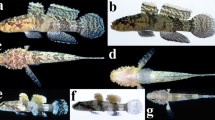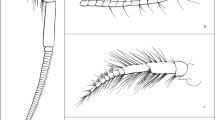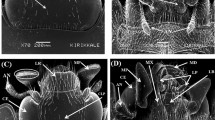Abstract
The occurrence, external morphology and internal ultrastructure of a cephalic integumental organ in calanoid copepods were studied, using the specimens from the Pacific, Indian and Atlantic Oceans. This organ is located on the dorsoanterior surface of the cephalosome, and a name, cephalic dorsal hump (CDH) is proposed. Externally, it usually has two pores, anterior and apical, a dorsal plate, and a thin cuticle along the sides. CDH is found only in the male of Calanidae, Megacalanidae, Mecynoceridae and Paracalanidae, and showed some variation between species or species groups both in size and shape. Transmission electron microscopy (TEM) on the specimens from Sagami Bay, Central Japan, revealed that the CDH of Paracalanus parvus and Calanus sinicus consists of two dermal glands and a receptor, which is assumed to be chemosensory. A comparison of the distributions of CDH and prehensile fifth legs of male calanoid copepods suggests that it plays an important role in mate recognition.
Similar content being viewed by others
Literature cited
Ache, B. W. (1982). Chemoreception and thermoreception. In: Atwood, H. L., Sanderman, D. C. (eds.) The biology of Crustacea. Vol. 3. Neurobiology: structure and function. Academic Press, New York, p. 369–398
Altner, H., Prillinger, L. (1980). Ultrastructure of invertebrate chemo-, thermo-, and hygroreceptors and its functional significance. Int. Rev. Cytol. 67: 139–153
Andronov, V. N. (1970). Some problems of taxonomy of the family Paracalanidae (Copepoda). Zool. Zh. 49: 980–985 (In Russian)
Andronov, V. N (1972). Some new species of the genus Parvocalanus (Copepoda, Paracalanidae). Zool. Zh. 51: 139–141 (In Russian)
Andronov, V. N. (1973). Taxonomic status of Mecynacera clausi (Copepoda, Calanoida). Zool. Zh. 52: 1719–1721 (In Russian)
Andronov, V. N. (1974). Phylogenetic relations of large taxa within the suborder Calanoida (Crustacea, Copepoda). Zool. Zh. 53: 1002–1012 (in Russian)
Blades, P. I., Youngbluth, M. J. (1980). Morphological, physiological and behavioral aspects of mating in calanoid copepods. In: Kerfoot, W. C. (ed.) Evolution and ecology of zooplankton communities. University Press of New England, Hanover, p. 39–51
Bowman, T. E. (1971). The distribution of calanoid copepods off the southeastern United States between Cape Hatteras and southern Florida. Smithson. Contr. Zool. 96: 1–58
Bradford, J. M. (1970). Records of pelagic copepods off Kaikoura, New Zealand. N. Z. J.mar. Feshwat. Res. 4: 351–363
Bradford, J. M. (1978). Paracalanus indicus Wolfenden and Corycaeus aucklandicus Kraemer, two neritic pelagic copepods from New Zealand. J. Roy. Soc. N. Z. 8: 133–141
Bradferd, J. M., Jillet, J. B. (1974). A revision of generic definitions in the Calanidae (Copepoda, Calanoida). Crustaceana 27: 5–16
Briggs, R. P. (1978). Structure of the integument in Paranthessius anemoniae Claus, a copepod associate of the snakelocks anemone Anemonia sulcata (Pennant). J. Morphol. 156: 293–316
Brodsky, K. A. (1972). Phylogeny of the family Calanidae (Copepoda) on the basis of a comparative morphological analysis of its characters. In: Zvereva, Zh. A. (ed.) Geographical and seasonal variability of marine plankton. Exploration of marine Fauna XII (XX). Academy of Sciences of USSR. Leningrad, p. 1–227 [Translated from Russian by Israel Program for Scientific Translations, Jerusalem 1975]
Brodsky, K. A., Vishkvartseva, N. V., Kos, M. S., Marhaseva, E. L. (1983). Copepod crustaceans in the seas of the USSR and adjacent waters. Vol. 1. Nauka, Leningrad (In Russian)
Dudley, P. (1972). The fine structure of a cephalic sensory receptor in the copepod Doropygus seclusus Illg (Crustacea: Copepoda: Notodelphyidae). J. Morphol. 138: 407–432
Elofsson, R. (1971). The ultrastructure of a chemoreceptor orga in the head of copepod crustaceans. Acta Zool., Stockh. 52: 299–315
Fleminger, A. (1973). Pattern, number, variability and taxonomic significance of integumental organs (sensilla and glandular pores) in the genus Eucalanus (Copepoda, Calanoida). Fish. Bull. U. S. 71: 965–1010
Fleminger, A. (1985). Dimorphism and possible sex change in copepods of the family Calanidae. Mar. Biol. 88: 273–294
Fredman, M. M. (1980). Comparative morphology and functional significance of copepod receptors and oral structures. In: Kerfoot, W. C. (ed.) Evolution and ecology of zooplankton communities. University Press of New England, Hanover, p. 185–197
Friedman, M. M., Strickler,J. R. (1975). Chemoreception and feeding in calanoid copepods.Proc. natn. Acad. Sci. U.S.A. 72: 4185–4188
Gharagozlou-van Ginneken, I. D. (1977). Contribution a l'etude infrastructurale des glandes labrales de quelques Harpacticoides (Crustaces Copepodes). Archs Biol, Paris 88: 79–100
Gharagozlou-van Ginneken, I. D. (1979). Etude ultrastructurale et cytochimique de l'activitie temporaire des glandes tegumentaires d'un Crustace Copepods.Annls. Sci. nat. Zool. 13, ser. 1: 205–212
Ghiradella, H., Case, J. F., Cronshaw, J. (1968). Fine structure of the aesthetasc hairs of Coenobita compressus Edwards. J. Morphol. 124: 361–386
Giesbrecht, W. (1892). Systematik und Faunistik der pelagischen Copepoden des Golfes von Neapel und der angrenzenden Meeres-abschnitte. Fauna Flora Golf. Neapel 19: 1–831
Gill, C. W. (1985). The response of a restrained copepod to tactile stimulation. Mar. Ecol. Prog. Ser. 21: 121–125
Gill, C. W. (1986). Suspected mechano- and chemosensory structures of Temora longicornis (Copepoda: Calanoida). Mar. Biol. 93: 449–457
Gill, C. W., Crisp, D. J. (1985). Sensitivity of intact and antennule ampulated copepods to water disturbance. Mar. Ecol. Prog. Ser. 21: 221–227
Gnatzy, W. (1984). “Campaniform” structures on lobster anatennule are dermal glands. Cell Tissue Res. 236: 729–731
Gonzalez, J. G., Bowman, T. E. (1965). Planktonic copepods from Bahia Fosforescente, Puerto Rico, and adjacent waters. Proc. U.S. nat. Mus. 117: 241–291
Gotto, R. V., Holmes, J. M. C., Lowther, R. P. (1984). Description of the adult male Mycophylus roseus Hesse (Copepoda: Cyclopoida): a copepod with remarkable sensory equipment. Ir. Nat. J. 21: 305–313
Gotto, R. V., Threadgold, L. T. (1980). Observations and speculations on the alate processes of the ascidicolous copepod Notopterophorus papilio (Cyclopoida: Notodelphydae). J. Zool., Lond. 190: 337–363
Greenwood, J. G. (1976). Calanoid copepods of Moreton Bay (Queensland). I. Families Calanidae, Eucalanidae, and Paracalanidae. Proc. R. Soc. Queensl. 87: 1–28
Griffiths, A. M. Frost B. W. (1976). Chemical communication in the marine planktonic copepods Calanus pacificus and Pseudocalanus sp. Crustaceana 30: 1–8
Gurney, R. (1927). Copepoda and Cladocera of the plankton. Zoological results of the Cambridge Expedition to the Suez Canal, 1924. Trans. zool. Soc. London 22: 139–172
Hill, L. L., Coker, R. E. (1930). Observations on mating habits of Cyclops. J. Elisha Mitchell Sci. Soc. 45: 206–220
Hipeau-Jacquotte, R. (1987). A new cephalic type of presumed sense organ with naked dendritic ends in the atypical male of the parasitic copepod Pachypygus gibber (Crustacea). Cell Tissue Res. 245: 29–35
Hipeau-Jacquotte, R. (1987). Ultrastructure and presumed function of the pleural dermal gland in the atypical male of the parasitic copepod Pachypygus gibber (Crustacea: Notodelphydae). J. crust. Biol. 7: 60–70
Jacoby, C. A., Youngbluth, M. J. (1983). Mating behavior in three species of Pseudodiaptomus (Copepoda: Calanoida). Mar. Biol. 76: 77–86
Katona, S. K. (1973). Evidence for sex pheromones in planktonic copepods. Limnol. Oceanogr. 18: 574–583
Katona, S. K. (1975). Copulation in the copepod Eurytemora affinis (Poppe, 1880). Crustaceana 28: 89–94
Landry, M. R. (1980). Detection of prey by Calanus pacificus: implications of the 1st antennae. Limnol. Oceanogr. 25: 545–549
Laverack, M. S. (1968). On the receptors of marine invertebrates. Oceanogr. mar. Biol. A. Rev. 6: 249–324
Laverack, M. S. (1988). The diversity of chemoreceptors. In: Atema, J., Fay, R. R., Popper, A. N., Tavolga, W. N. (eds.) Sensory biology of aquatic animals. Springer-Verlag, New York, p. 287–312
Laverack, M. S., Barrientos, Y. (1985). Sensory and other superficial structures in living marine Crustacea. Trans. R. Soc. Edinb. Earth Sci. 76: 123–136
Marshall, S. M., Orr, A. P. (1955). The biology of a marine copepod: Calanus finmarchicus (Gunnerus). Oliver & Boyd, Edinburgh
Mauchline, J. (1977). The integumental sensilla and glands of pelagic Crustacea. J. mar. biol. Ass. U.K. 55: 973–994
Mauchline, J. (1988). Taxonomic value of pore pattern in the integument of calanoid copepods (Crustacea). J. Zool., Lond. 214: 697–749
McIver, S. B. (1975). Structure of cuticular mechanoreceptors of arthropods. A. Rev. Entomol. 20: 381–397
Mori, T. (1937). The pelagic copepods from the neighbouring waters of Japan. Yōkendō, Tokyo
Nishida, S. (1986). Structure and function of the cephalosome-flap organ in the family Oithonidae (Copepoda, Cyclopoida). Syllogeus 58: 385–391
Noirot, C., Quennedey, A. (1974). Fine structure of insect epidermal glands. A. Rev. Entomol. 19: 61–80
Ong, J. E. (1969). The fine structure of the mandibular sensory receptors in the brackish water calanoid copepod Gradioferens pectinatus. Z. Zellforsch. mikrosk. Anat. 97: 178–195
Sars, G. O. (1903). Copepoda Calanoida. Calanidae, Eucalanidae, Paracalanidae, Pseudocalanidae, Aetideidae (part). Acc. Crustacea Norw. 4: 1–28
Sato, T. (1913). Pelagic copepods. I. Bull. Hokkaido Fish. Exp. St. 1: 1–79 (In Japanese)
Strickler, J. R., Bal, A. K. (1973). Setae of the 1st antennae of the copepod Cyclops scutifer: their structure and importance. Proc. natn. Acad. Sci. U.S.A. 70 2656–2659
Tanaka, O. (1954). Note on Calanus tonsus Brady in Japanese waters. J. oceanogr. Soc. Japan. 10: 1–11
Tanaka, O. (1956). The pelagic copepods of the Izu region, middle Japan. Systematic account II. Families Paracalanidae and Pseudocalanidae. Publ. Seto mar. biol. Lab. 3: 367–406
Tanaka, O. (1960). Pelagic copepoda. Spec. Publs Seto mar. biol. Lab., Biol. Results Jap. Antarct. Res. Exped. 10: 1–177
Uchima, M., Murano, M. (1988). Mating behavior of the marine copepod Oithona davisae. Mar. Biol. 99: 39–45
Vaupel-Klein, J. C. von (1982). Structure of integumental perforations in the Euchirella messinensis female (Crustacea, Copepoda, Calanoida). Neth. J. Zool. 32: 374–394
Vervoort, W. (1951). Plankton copepods from the Atlantic sector of the Antarctic. K. Ned. Akad. Wet., Verh. Afd. Nat. (Tweede Sect.). 47: 1–156
Wellershaus, S. (1969). On the taxonomy of planktonic Copepoda Backwater (a South Indian Estuary). Veroff. Inst. Meeresforsch. Bremerh. 11: 245–286
Zheng, Z., Li, S., Li, S., Cheng, B. (1982). Marine pelagic copepods in China. Vol. 2. Shanghai Science and Technology Pub. Co., Shanghai (In Chinese)
Author information
Authors and Affiliations
Additional information
Communicated by M. Anraku, Tokyo
Rights and permissions
About this article
Cite this article
Nishida, S. Distribution, structure and importance of the cephalic dorsal hump, a new sensory organ in calanoid copepods. Mar. Biol. 101, 173–185 (1989). https://doi.org/10.1007/BF00391456
Accepted:
Issue Date:
DOI: https://doi.org/10.1007/BF00391456




